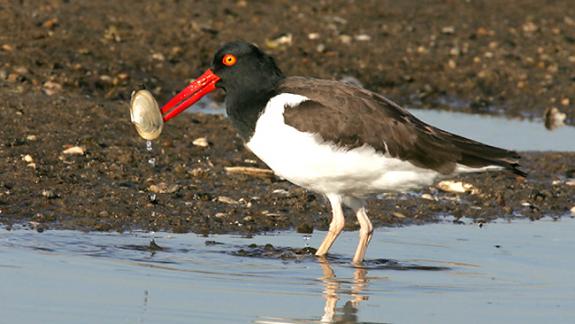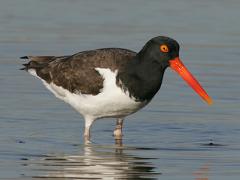American Oystercatcher
The American Oystercatcher (Haematopus palliatus) is listed as a species of special conservation concern. This species is considered to be in decline in New Jersey.
 An American oystercatcher. © Chris Davidson
An American oystercatcher. © Chris Davidson
If you spend time along the New Jersey coast, there’s a good chance you have seen or heard an American oystercatcher. Standing nearly a foot and a half tall with a long orange-red bill, the stocky black, brown, and white oystercatcher is not easily overlooked. Their loud calls and gregarious behavior makes them even harder to miss.
Despite being so striking, you may not have heard as much about the oystercatcher as you have heard about other coastal species, such as the osprey or piping plover. In fact, until recently, significant information gaps existed about oystercatchers in the state. That is changing now that researchers have begun to focus more attention on them.
Once abundant along the entire Atlantic coast, oystercatchers were believed to be extirpated in the Northeast as a result of intensive market hunting and egg collecting in the 1800’s. With the passage of the Migratory Bird Treaty Act of 1918, the oystercatcher began to rebound. However, various factors including habitat loss from coastal development, human disturbance from recreational activity and elevated predator levels have kept the population low.
Just how low is one of the questions biologists are now addressing. A range-wide aerial survey from New Jersey to Florida and the Gulf coast conducted in the winter of 2002-03 led to a population estimate of approximately 11,000 oystercatchers. In 2003, biologists in New Jersey began including oystercatchers in their annual breeding surveys of other beach nesting birds. Those surveys have found on average, about 60 breeding pairs on barrier beaches. However, because oystercatchers nest on back-bay marsh habitat as well, this only reflects a portion of the population.
 Zoom+ American oystercatcher. © Chris Davidson
Zoom+ American oystercatcher. © Chris Davidson
In 2004, Tom Virzi, a PhD candidate at Rutgers University, began studying oystercatchers in hopes of better identifying the factors that impact reproductive success in the different nesting habitats. Virzi’s research quickly revealed that more oystercatchers were nesting in the back-bay areas, especially near inlets, than on the barrier beach strands. However, it wasn’t until 2007 that Virzi was able to survey most of the state’s suitable nesting habitat in the coastal zone. He found 332 breeding pairs, substantially more than expected. Because some areas were not included on the survey, experts estimate that approximately 400 pairs of oystercatchers nest in New Jersey.
Virzi said, “The most exciting finding from my research has been locating such a large number of oystercatchers breeding on salt marsh and back-bay islands in New Jersey. I think this has major conservation implications for the species since we are now able to identify and begin protecting important breeding areas away from the barrier beach strands.”
New Jersey is also important for oystercatchers during the non-breeding season. As the northernmost state in the wintering range, some years it is host to nearly 1,000 oystercatchers, slightly less than 10% of the population. Unlike during the breeding season when they are highly territorial, oystercatchers gather in large roost flocks in the fall and winter. The flocks, which are generally in or near inlets, vary considerably in size. In New Jersey, flocks in Absecon and Hereford inlets are especially important as they number 200-350 birds each and often account for the majority of birds present during the non-breeding season.
Although we know much more about oystercatchers now, many questions remain. We hope that continued monitoring and research will provide information about how long they live, chick survival rates, movement patterns, and population trends.
Oystercatchers are not currently listed as an endangered or threatened species in New Jersey, but experts are concerned enough to have recently proposed that their status be changed to a species of “special concern.” Other birds – piping plovers, least terns, and black skimmers – that share the same nesting habitats and face the same threats have already been listed. If oystercatchers are to avoid that fate, a comprehensive conservation effort guided by the recent surge in research is critical.
written by Todd Pover
Find Related Info: Beach Nesting Birds, Special concern





